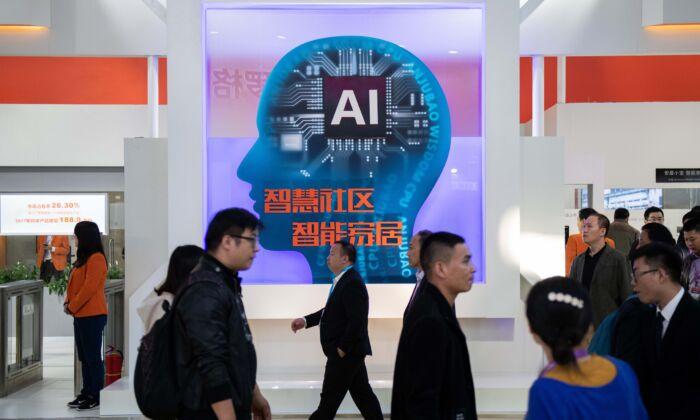Commentary
There’s a lot of buzz in artificial intelligence (AI) circles and the media about how China may be leading the world in this most critical of technologies.
DeepSeek, a new startup from China, recently stunned the United States with its superior performance against OpenAI’s, Google’s, or Meta’s popular AI models.
In terms of global power and influence, the stakes couldn’t be higher. In just a decade, China has become a global leader in AI technology.
Although China’s rapid progress has largely been driven by state initiatives for public security and social control, there are some critical weaknesses.
In which areas of AI does China lead or lag, and what does it mean for the U.S. AI industry and the world at large?
A Global Leader in Key AI Categories
China leads the world in several key AI-driven technologies and patents. One particular area is facial recognition and surveillance technology.Not surprisingly, the Chinese Communist Party’s integration of AI with its vast surveillance networks has given China an unrivaled edge in this domain. Companies such as SenseTime and Megvii have developed highly sophisticated systems that have been deployed across so-called smart cities.
Another area of AI dominance is in speech recognition. Tech giants such as Baidu, Alibaba, and Tencent have elevated speech recognition to an amazing level with applications in customer service, smart home devices, and translation services. However, considering that most of the focus is on Mandarin and other Chinese dialects, the impact remains limited mainly to China.
A third area of China’s AI dominance is in drone technology. Chinese firms, such as DJI, are widely believed to lead the global consumer drone market in the manufacturing and application of AI for autonomous flight and real-time data processing. These advances have proven critical in border patrol and battlefield operations in Ukraine.
What’s more, under Chinese Communist Party (CCP) initiatives such as “Made in China 2025,” China has integrated AI into many of its industrial processes. As a result, China leads in smart manufacturing with AI-optimized production lines, automated machine maintenance, and AI-driven quality control.
Where China Lags in AI Development
But unlike widely adopted U.S. deep learning frameworks such as TensorFlow (Google) or PyTorch (Meta), most Chinese AI deep learning versions aren’t globally accepted or used. This lack of transferability is an obstacle for China’s AI industry.China’s AI industry is also behind in semiconductor technology, especially in training large models, which are critical for AI development and applications. U.S. export controls on advanced chips are cited as a big reason why. Currently, China’s dependency on foreign technology hinders its ability to gain technological independence in AI hardware, but that may already be changing.
Another vulnerability for China’s AI development is in Cloud services. Even with established companies such as Alibaba Cloud, China remains a second-tier provider globally. While China holds and continues to gather vast amounts of data, its AI frameworks aren’t nearly as good at managing data effectively for AI applications, especially in terms of privacy and security, and fall well short of European and even U.S. standards.
Implications of China’s AI Leadership
The CCP’s focus on surveillance and control of 1.4 billion people has driven its rapid deployment of technologies across its vast populations and its integration of AI into state security apparatuses. This has supported the CCP’s power without concerns about privacy, ethical AI use, and potential abuse of technology for surveillance.While the centralized regime can enforce application and scaling, state constraints on openness, the exchange of ideas, and fundamental research impinge on innovation. Recent events in China have shown that as overall economic performance lags, Party control over expression increases while innovation in some areas of AI decreases. In short, China’s AI growth curve seems formidable but uneven.
The US Innovation Advantage
In contrast with China’s centralized regime, the United States benefits from a dynamic ecosystem of universities, tech startups, and established companies that drive innovation on multiple fronts, including in AI.In fact, open-source contributions from U.S. companies have significantly shaped AI development worldwide. In the United States, a small number of big players—such as OpenAI, Meta, Google, and Anthropic—dominate the field.
This unbridled dynamism attracts a rich and diverse pool of talent from around the world. Along with U.S. academic prestige, a high-paying tech job market gives it a serious lead over China in AI research and application development.
Furthermore, U.S. firms such as Nvidia dominate the production of AI hardware, such as GPUs, which are crucial for AI model training. Again, this gives the United States an edge in computational capabilities and technology sovereignty that China currently lacks.
With regard to AI ethics, transparency, and responsibility, U.S. companies typically lead the discussion. This level of ethical trust leads to more sustainable and globally accepted AI solutions from U.S. companies.
The Wild West Approach to AI Has Its Disadvantages
Unlike China’s highly focused approach, U.S. policy on AI is much less coordinated, with varied approaches to regulation, funding, and direction, both on state and federal levels. While the open approach fosters innovation, it also disperses focus.Regarding data privacy, the United States faces its own challenges in the privacy sphere. Lack of privacy guarantees can result in data sharing hesitancy for AI training. That contrasts with China’s focus on data capture and less restrictive policies about data privacy.
There is also a tradeoff in the U.S. AI industry in terms of funding and focus. The tension between short-term commercialization and long-term research is real, especially in the venture capital space. More consistent government backing into long-term innovations could help the United States.
Who Will Prevail in the AI Race?
China is pushing for technological self-sufficiency, particularly with regard to semiconductors. If the Chinese are successful, they could quickly surpass the United States in AI development to become an AI superpower.Current economic and geopolitical tensions between China and the United States, as well as with Europe, could delay Beijing’s self-sufficiency goals, or it could spur Chinese chip development and speed up self-sufficiency. In any case, China’s ability to scale AI applications delivers immediate economic and strategic advantages, particularly in surveillance and manufacturing.
Some experts believe that neither the United States nor China will completely dominate AI’s future. Rather, leadership will likely be sector-specific, with the United States potentially leading in AI innovation and ethical application, while China might excel in AI’s practical, large-scale implementation. But in the race for AI dominance, neither nation is interested in or can afford to come in second place.
Views expressed in this article are opinions of the author and do not necessarily reflect the views of The Epoch Times.







